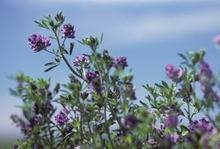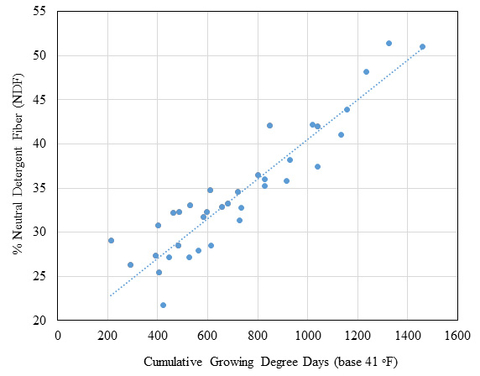When spring approaches, alfalfa growers need a plan for optimizing the first harvest’s nutritive value and yield. Here, you'll find strategies for making in-field predictions of alfalfa nutritive value, and when and how they should be used.
Some crop growth predictions are based on environmental information, while others are based on directly measuring the crop in the field. Tracking the accumulation of growing degree days (GDD) is a common approach for estimating the crop’s growth and maturity in the field based on actual temperature conditions rather than calendar days.
Understanding growing degree days (GDD)
Growing degree days are calculated by subtracting a base temperature from the average of daily high (Tmax) and low (Tmin) temperatures, as shown.
The resulting value is an indicator of how high temperatures were relative to the minimum required temperature for plant growth to occur. This base temperature for alfalfa is 41 degrees Fahrenheit.
Cumulative GDD (adding all GDD to-date) indicates how much warm weather has accumulated throughout the growing season up to a given point.
In situations where heat is the only limiting factor – meaning, there’s ample water and nutrients, no pest pressure, etc. – GDD accumulation is an excellent predictor of crop growth. GDD estimations are most accurate for alfalfa nutritive value in the early growing season leading up to the first harvest, when moisture usually isn’t limited.
Planning the first cut
In the upper Midwest, it’s generally recommended to plan the first cut near the accumulation of 700 to 750 GDD.
This is intended to achieve a neutral detergent fiber (NDF) concentration near 35 percent at harvest, resulting in NDF concentrations near 40 percent – with a relative feed value (RFV) of approximately 150 – when used as feed or sold as hay.
While the 700 to 750 GDD recommendation is consistent with observed values in a 2015 alfalfa trial in Rosemount (Figure 1), the best approach is to identify the target specific to your production goals and region.
If there are records comparing alfalfa harvest dates and corresponding nutritive value, you can use online tools such as the Midwest Climate Center tool cli-MATE to calculate cumulative GDD values from specific days in previous years. Remember to adjust the base temperature value to 41 degrees Fahrenheit.
Looking back
When looking back at the cumulative GDD at harvest, consider whether you got the desired forage quality.
Understanding the relationship between environmental conditions and forage quality highlights the importance of maintaining farm records. Records should include include:
-
Harvest date.
-
Forage nutritive value, including NDF, acid detergent fiber (ADF) and crude protein (CP).
-
Yield.
Comparisons will indicate whether you harvested too early, too late or met your goal, and will inform future harvests based on cumulative GDD.
Planning ahead
When planning ahead, use GDD estimations to forecast the date of a given cumulative GDD value. Recent averages from Rosemount indicate GDD accumulation will reach 700 around May 25 (Figure 2).
However, with climatic fluctuations each year and different goals among producers, it’s important to keep a close eye on current and forecasted conditions in your specific area.
As you use this information, remember that GDD-based forage nutritive value estimates are most consistent for the first harvest.
Later in the season, use physical measurements of maturity and height to estimate nutritive values. The PEAQ system combines maturity and height for an estimate.
Direct measurements (growth staging) or destructive sampling (lab analysis) can more accurately predict nutritive value, as other environmental factors become more limiting later in the season. While these methods can provide useful information, they’re labor-intensive, time-consuming and rarely adequate for field-scale assessments.
Lee, K., Allen, M., & Leep, R. (2010). Predicting optimum time of alfalfa harvest. Michigan State University.
Martens, D. (2011). Central MN Alfalfa Harvest Alert (May 26 Update). University of Minnesota Extension.
Noland, R.L., Sheaffer, C.C., & Wells, M.S. (2015). In-field assessment of alfalfa quality: Current tools and future directions. University of Minnesota Extension.
Noland, R.L., Wells, M.S., & Sheaffer, C.C. (2017). Integrating canopy reflectance with environmental factors for in-situ estimations of alfalfa nutritive value. Field Crops Research. (in preparation).
Schroeder, J.W. (2010). Timing is important when harvesting alfalfa as feed for dairy cows. North Dakota State University Extension.
Sulc, R.M, Albrecht, K.A., Owens, V.N., & Cherney, J.H. (2014). Update on predicting harvest time for alfalfa.
Reviewed in 2023





